Hadaka Matsuri – Naked Man Festival
Friday, March 5th, 2010 in: News, Travel
I arose from my nap and rubbed dreamily at my eyes. mid-day naps are the best for recharging my batteries, especially considering the strange hours I tend to keep. Tonight’s the big night of the 裸祭り: Hadaka Matsuri, Naked Man Festival. One of Japan’s top three crazy 奇祭, weird festivals, the Hadaka Matsuri consists of thousands of naked men wrapped in loincloths, scrambling for two “lucky sticks” (宝木, Shingi) thrown down from a temple window. The sticks are immersed in incense for two weeks, and smell so strongly that it’s said that if you touch one, you won’t be able to wash the smell off your hands for days. The men who manage to claw their way to the sticks and smuggle them out of the temple grounds somehow are considered extremely lucky (and not just to have survived the ordeal) and are carried on their comrades’ shoulders to a special place where the stick is verified by temple priests and they are proclaimed 福男, fukuotoko, the lucky men. Another custom of note is that presenting your fundoshi to a woman is a surefire way to get her pregnant. I’m not sure if it needs to be unwashed or not… I don’t need that sort of drama in my life right now, so 今年、褌を締めるつもりはない。
 We could see the fireworks in the direction of the temple as we stepped out of the station. lanterns were strewn about town to remind us there was a festival going on. The population density rose as we approached the temple grounds, but we were stopping at Kou’s place first. Ryan warned me that his grandma is very genki (energetic, lively) and will talk forever regardless of whether you understand her or not. My kinda lady! We were close to Kou’s when we had our first Hadaka-sighting (hadaka means naked, but in this situation it’s used as a pronoun for anyone in a fundoshi).
We could see the fireworks in the direction of the temple as we stepped out of the station. lanterns were strewn about town to remind us there was a festival going on. The population density rose as we approached the temple grounds, but we were stopping at Kou’s place first. Ryan warned me that his grandma is very genki (energetic, lively) and will talk forever regardless of whether you understand her or not. My kinda lady! We were close to Kou’s when we had our first Hadaka-sighting (hadaka means naked, but in this situation it’s used as a pronoun for anyone in a fundoshi).  Three nearly naked men were standing outside a brightly lit shop, huddled in a circle and shivering uncontrollably as they furiously sucked down cigarettes, as if the embers from the tobacco would keep them warm if they puffed hard enough on them.
Three nearly naked men were standing outside a brightly lit shop, huddled in a circle and shivering uncontrollably as they furiously sucked down cigarettes, as if the embers from the tobacco would keep them warm if they puffed hard enough on them.
The Hadaka are usually groups of coworkers, friends or colleagues of some sort, turning the whole festival into a sort of deadly teambuilding exercise. To keep warm and build up energy for the coming event, the groups would march through the streets, carrying banners and mikoshi (like small parade floats for festivals), chanting “WASSHOI! WASSHOI!” as the crowd cheers them on. To clear the street for an oncoming group, the police would yell 裸が通ります! Naked guys coming through!
I was a little taken aback at how many foreigners were loitering around the yatai (food stands), and even more were strutting around in fundoshi, looking excited and confused… but I suppose it’s to be expected: Hadaka Matsuri is one of the major “weird festivals” in Japan, right up there with the “Penis Festival,” which has gotten so much press in recent years. You can google that one yourself. My point is that there are many places that experience this phenomenon: small towns with relatively small populations just explode with people once a year. One day there’s nary a soul in sight (like when we checked out the temple the day before), and the next the streets are completely choked with bodies. In the fall, even Imbe is jam-packed with people for the Bizen-yaki Pottery Festival.
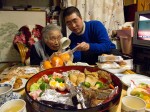 Kou’s grandmother was as advertised, a slight but sprightly woman, 92 years young. She was very excited to have us over, smiling broadly and offering us homemade sushi and hot tea. Her hearing wasn’t so great but it didn’t matter so much; we let her do most of the talking with her thick Okayama dialect. When there was something worth saying, I had Kou translate from either English or standard Japanese into Okayama-ben, about 30 decibels louder. She was a lot of fun.
Kou’s grandmother was as advertised, a slight but sprightly woman, 92 years young. She was very excited to have us over, smiling broadly and offering us homemade sushi and hot tea. Her hearing wasn’t so great but it didn’t matter so much; we let her do most of the talking with her thick Okayama dialect. When there was something worth saying, I had Kou translate from either English or standard Japanese into Okayama-ben, about 30 decibels louder. She was a lot of fun.
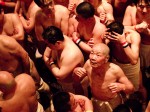 We were running out of time, and Kou’s mom (who also volunteered at the temple) scored us tickets to actually go into the temple and view the Hadaka from the window they perform the 宝木投下 (airdrop of the lucky sticks). We were the last ones into the Temple, so we got to watch the Hadaka gathering on the veranda underneath the window, jostling for a good position, shivering in the cold, and keeping their arms raised to avoid being pushed to the ground and trampled.
We were running out of time, and Kou’s mom (who also volunteered at the temple) scored us tickets to actually go into the temple and view the Hadaka from the window they perform the 宝木投下 (airdrop of the lucky sticks). We were the last ones into the Temple, so we got to watch the Hadaka gathering on the veranda underneath the window, jostling for a good position, shivering in the cold, and keeping their arms raised to avoid being pushed to the ground and trampled. 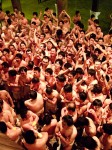 There are a lot of injuries at this festival, most of them due to the sheer number of people pressing against each other; it’s like a tsunami of human bodies, a force of nature. More on that later. A temple worker was ladling water out of a bucket and throwing it out over the crowd–this was to help prevent epic rug burns. Each time water was splashed on the crowd, the men would shout in excitement. The temperature was rising in more than one way. As the crowd thickened, steam began to rise off their bodies; if it weren’t for the water, they would surely have caught on fire from all the friction.
There are a lot of injuries at this festival, most of them due to the sheer number of people pressing against each other; it’s like a tsunami of human bodies, a force of nature. More on that later. A temple worker was ladling water out of a bucket and throwing it out over the crowd–this was to help prevent epic rug burns. Each time water was splashed on the crowd, the men would shout in excitement. The temperature was rising in more than one way. As the crowd thickened, steam began to rise off their bodies; if it weren’t for the water, they would surely have caught on fire from all the friction.
httpvh://www.youtube.com/watch?v=5girTjwEmFI
We were the last ones ushered out of the temple before the priests held their secret ceremony to bless the Shingi. I stepped out of the side entrance to the temple and back into my shoes. The sea of people had parted to create a path that wound around the temple grounds, allowing the increasing flow of Hadaka into the main staging area for the upcoming battle. We still had a while to before the actual event would take place, so Kou led us around the food stands and we picked up some castella from his favorite yatai. The ojisan running the stand recognized Kou and they exchanged some friendly words as he ejected the hot spongecakes from their iron moulds. Not many castella carts cook their cakes to order, which is what brings Kou back to this particular yatai every year. Our breaths were already visible in the crisp night air, but now we spouted steam like hot kettles; our tongues danced to avoid the molten bread swirling in our mouths. I bought another bag.
httpvh://www.youtube.com/watch?v=uq3u1l20QlQ
As I had mentioned before, tonight was the 500th anniversary of the Hadaka Matsuri at Saidaiji. There are many local festivals like it around the country, but this is the biggest and longest-running event of its kind. Tonight also marked a surprising change of pace, which seemed to throw everyone working the festival for a bit of a loop: instead of the traditional dropping of the sticks at the strike of midnight, the shingi touka was moved up to 10pm. Various reasons were cited for the change, and from what I gathered, it was partly a safety precaution for the crowds and for the participants, but I suspect it was also to help ensure that all the people who had commuted in to see the event wouldn’t miss the last train of the evening. I’m sure the yatai workers and cabbies weren’t too happy about their profits for the night being cut short, and there was much confusions amongst the event staff; it’s hard to break a 500 year habit.
When we first got into Okayama, Keiko’s friend (the bringer of delicious coffee) told us about the time he donned a fundoshi and joined the festival, 30 or 40 years ago. He gave us a good idea of what to expect, and explained the dangers and etiquette (why the men have to keep their arms above their shoulders, why they get doused with water, no punching or kicking, just pulling and scratching, and so on. Even with his help, I was not prepared to see so many naked men crowded around the temple, pressing themselves up the steep wooden steps, groping for two incense sticks. There was a 500 yen viewing area, a 1000 yen standing area, and 5000 yen seats immediately across from the temple. All were sold out by the time we got back to the temple grounds from our snack run. We made our way down to the grounds between the viewing areas and the temple, and though we had to swim through a thick fog of onlookers, we found that we had a better view than if we had paid. I almost had a clear shot of the writhing mass of bodies if it weren’t for a corner of the pagoda, but it was the best I could hope for. The crowd was so tightly packed together, I had to wonder who was in more danger, us or the Hadaka. The events that followed soon put that thought to rest.
httpvh://www.youtube.com/watch?v=nX_79DtCpLY
When the clock struck ten, the floodlights were all shut off at once, and the sticks were thrown into the darkness. The crowd went wild, and the flashes from a thousand cameras illuminated the violence like a giant naked all-male nightclub. Eventually some of the lights were turned back on, and you could barely make out the action. The men were so tightly packed on the platform that more than once a massive wave of them came tumbling down the stairs, sending ripples out into the crowd of Hadaka still plying their way toward the temple. The intensity of the situation was punctuated by the presence of hundreds of medical workers already hauling wounded men out of the area. Men on the platform and on the ground were yelling and pointing towards the center of the crowd, either trying to direct their friends or misdirect their opponents. At one point I swear I saw one of the Hadaka squeeze out of the side of the crowd and down the steps towards the exit. It seemed like one of the Shingi was making its way to freedom.
httpvh://www.youtube.com/watch?v=ado–jg14M4
Eventually a voice came over on the loudspeakers announcing that it “seems that the shingi has been taken from the temple grounds.” Once the shingi crosses the gate, it’s considered a done deal; any fighting beyond that point disqualifies you. Kou shook his head and said that it’s often a ruse to get the Hadaka to calm down a little bit, even if the Shingi is still around. The veterans know this, and continued their valient struggle. Several confused-sounding announcements later, the Hadaka had finally had their fill of the fighting, and had resorted to standing around, grasping their sides and shivering in the wind. The crowd was so massive that the men on the temple floor were forced to wait for 20 minutes before they were able to descend from the platform.
httpvh://www.youtube.com/watch?v=KhMBlnTK8Uc
Kou led us to the building just outside the temple grounds where the fukuotoko were brought for verification. TV camera crews and curious bystanders lined the streets and waited for the sound of the whistle and the triumphant shouts of “WASSHOI, WASSHOI!” as the first, and then second fukuotoko were carried into the building.
httpvh://www.youtube.com/watch?v=JxRfs9pqEZI&NR=1
Having seen almost everything the Hadaka Matsuri had to offer, we turned back to Kou’s house to recap the night’s events for his mother and grandmother, and to enjoy some more delicious food before heading back to Imbe. Kou asked me to perform a few yo-yo tricks and he brought out his new Hyper Yo-Yo he had picked up at Bic Camera the day before. It was really cool to see someone pick up a yo-yo again and try it after all these years. The evening ending on a happy note, Kou’s mom drove us back to the station, and he even bought a ticket to enter the platform for 見送り, seeing us off. I had forgotten about this custom and was a little surprised at first, but then I realized that he and Ryan had a long history together and they don’t see much of each other, and this was the last time this trip we’d be able to meet. When the train pulled away, Kou began to run alongside it, waving vigorously the whole time. We waved back and laughed to each other until he disappeared into the distance. We sank into our chairs, completely spent from all the festivities. A mountain hike, good food, good friends, and a bunch of naked men… what more could you ask for?

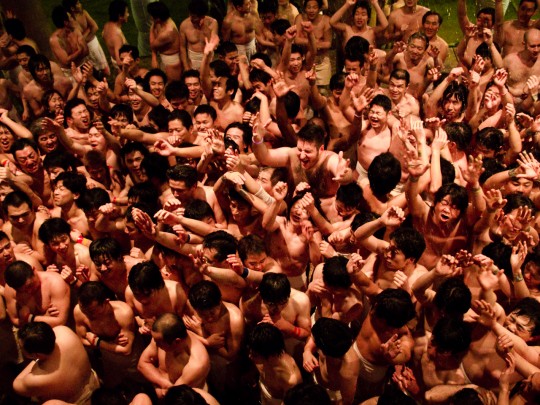



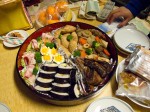



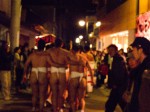
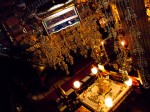
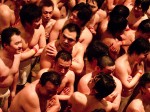

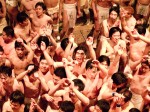
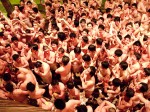

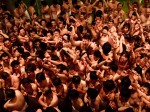
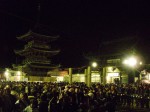
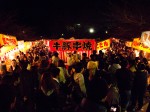
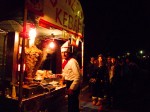
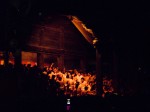
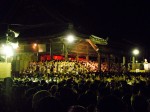
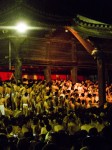
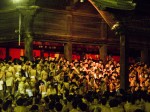
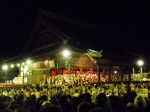
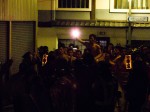
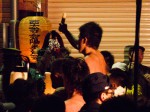
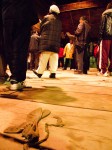
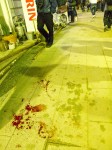
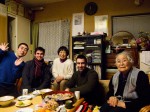
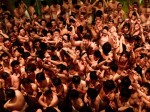







Leave a Reply